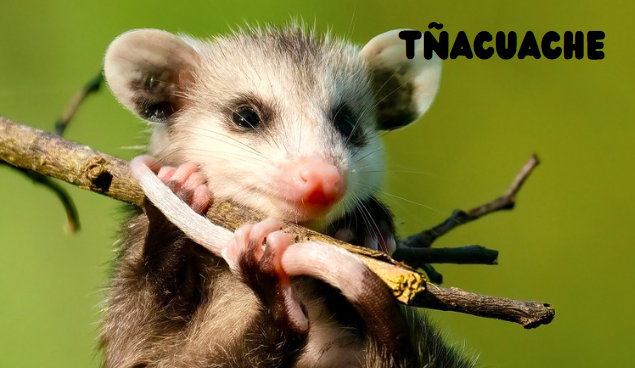The “tñacuache” is a fascinating and often misunderstood creature. While many Americans may not be familiar with the term, it refers to a species of opossum that plays a significant role in ecosystems and cultures, particularly in Latin America. This article dives deep into the characteristics, cultural relevance, and environmental impact of the tñacuache, providing a thorough exploration for readers who want to go beyond the basics.
1. Introduction to Tñacuache: What Is It?
The term “tñacuache” might sound unfamiliar to those in the United States, but in Latin American countries, it’s a well-known name for the opossum, specifically the Didelphis virginiana. The tñacuache belongs to the family Didelphidae, a group of marsupials primarily found in the Americas.
Origin of the Name
The word “tñacuache” has indigenous roots, believed to derive from Nahuatl, the language of the Aztecs, where it was originally “tlacuatzin” meaning “the little one who eats fire.” The creature earned this name due to its presence in fire-related myths and folklore. Despite its small size and humble appearance, the tñacuache has captured the imagination of many, both in ancient stories and modern wildlife narratives.
2. Physical Characteristics of Tñacuache
The tñacuache is a medium-sized marsupial, typically weighing between 4 and 12 pounds. Its body length ranges from 15 to 20 inches, not including its long, prehensile tail, which can add another 9 to 21 inches.
Size and Build
The tñacuache has a robust, stocky build with a pointed snout and a naked tail. Its grayish fur gives it a somewhat scruffy appearance, but its adaptability and agility make it a survivor. It has sharp claws designed for climbing, and its prehensile tail allows it to grasp branches, helping it navigate its environment.
Unique Features
What sets the tñacuache apart is its marsupial nature. Like kangaroos, female tñacuaches have a pouch where they carry and nurse their young. Additionally, tñacuaches are known for their remarkable immune system. They have a natural resistance to venom from certain snakes and exhibit low susceptibility to rabies.
3. Habitat and Range of Tñacuache
Geographic Distribution
The tñacuache, or opossum, is found throughout the Americas. In the U.S., it ranges from the eastern and southern states to Mexico and Central America. It is highly adaptable and thrives in various environments, including forests, grasslands, urban areas, and even suburban backyards.
Adaptability to Environments
Tñacuaches are omnivorous scavengers, making them adaptable to many habitats. They can be found in densely forested regions, near water sources, or in areas with abundant food sources such as fruit trees, gardens, and trash bins. Their ability to eat a wide variety of food, including fruits, small animals, and carrion, contributes to their survival in diverse environments.
4. The Role of Tñacuache in Ecosystems
Tñacuaches are essential contributors to their ecosystems. Their scavenging nature helps clean up waste and reduce disease risks by consuming dead animals. Additionally, they play a role in seed dispersal, which aids in the regeneration of plant life in forests and urban areas.
Seed Dispersal and Regeneration
As tñacuaches forage for fruits, they often consume seeds that pass through their digestive system unharmed. These seeds are then deposited in different areas, facilitating the spread of various plant species.
Pest Control
A lesser-known benefit of tñacuaches is their role in controlling pests. These animals are known to consume ticks and other insects, providing natural pest control in ecosystems where they are present.
5. Cultural Significance of Tñacuache in Latin America
In many Latin American countries, the tñacuache holds cultural significance that goes beyond its biological role. Its association with mythology, folklore, and even popular culture has made it a symbol in various traditions.
Tñacuache in Traditional Folk Medicine
In some cultures, parts of the tñacuache have been used in folk medicine. While these practices are declining due to modern scientific understanding, they highlight the tñacuache’s place in human culture throughout history.
Modern Representation in Pop Culture
Today, the tñacuache can also be found as a character in Latin American children’s books, television shows, and even as mascots for various events. It represents resilience, adaptability, and survival, which resonate with many communities.
6. Tñacuache in Mythology and Folklore
The tñacuache has long been featured in the mythology and folklore of indigenous cultures throughout the Americas. Often portrayed as a trickster, it plays a pivotal role in stories that explain natural phenomena and human behaviors.
The Myth of the Tñacuache and Fire
One of the most famous myths involving the tñacuache comes from the Aztec civilization. According to legend, the tñacuache was responsible for bringing fire to humans. In the story, the creature stole fire from the gods by carrying a burning ember in its tail, which is why its tail is now hairless.
Trickster Symbolism
In many indigenous stories, the tñacuache is a trickster figure, similar to the coyote in Native American mythology. It is portrayed as clever and mischievous, often using its wits to outsmart larger and more powerful animals or humans. This representation reflects the tñacuache’s real-life ability to adapt and survive in harsh environments.
7. Threats and Conservation of the Tñacuache
While the tñacuache is not currently listed as endangered, it faces several threats, particularly due to human activities. Habitat destruction, urbanization, and road accidents have had a significant impact on its populations in some areas.
Urbanization and Road Mortality
As human development expands, tñacuaches are increasingly forced into urban areas where they are often considered pests. Unfortunately, this puts them at risk of being killed by cars or trapped by homeowners who view them as nuisances.
Conservation Efforts
Conservationists are working to protect tñacuache populations by promoting coexistence between humans and wildlife. Educational campaigns aim to inform the public about the ecological benefits of tñacuaches and encourage humane methods of dealing with them.
FAQs
1. Are tñacuaches dangerous to humans?
No, tñacuaches are generally not dangerous to humans. They are shy creatures that prefer to avoid confrontation. If threatened, they may “play dead,” a behavior known as thanatosis.
2. What do tñacuaches eat?
Tñacuaches are omnivores and have a varied diet that includes fruits, small animals, insects, and carrion. They are also known to scavenge in urban areas.
3. Can tñacuaches carry diseases?
While tñacuaches can carry parasites, they have a remarkably low risk of transmitting rabies to humans. Their body temperature is lower than most mammals, which makes them less susceptible to the virus.
4. Why do tñacuaches have a hairless tail?
The hairless tail of the tñacuache is prehensile, meaning it can grasp objects like tree branches. According to folklore, the hairlessness is attributed to the myth of the tñacuache stealing fire from the gods.
Conclusion
The tñacuache is a remarkable animal that has adapted to thrive in a variety of environments, from forests to urban landscapes. Its role in the ecosystem as a scavenger and seed disperser is vital, and its cultural significance in Latin American mythology adds depth to its story. While often misunderstood, the tñacuache deserves respect and protection, as it continues to play an important role in maintaining ecological balance.
Understanding the tñacuache helps foster a greater appreciation for this often-overlooked creature, making it clear why it holds such a prominent place in both nature and culture.


No responses yet